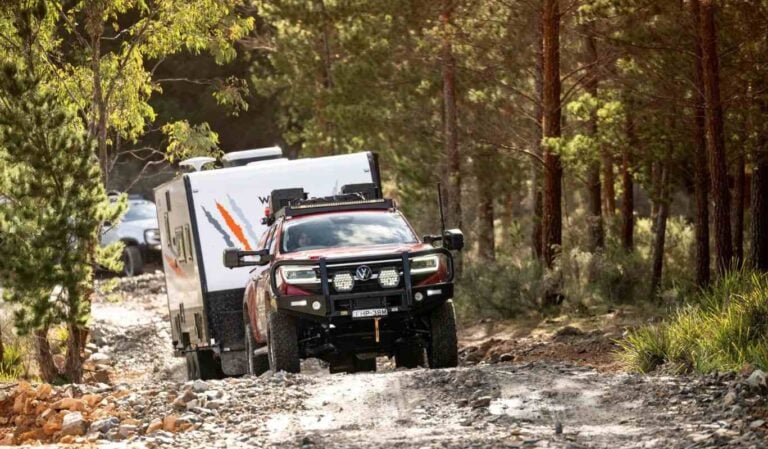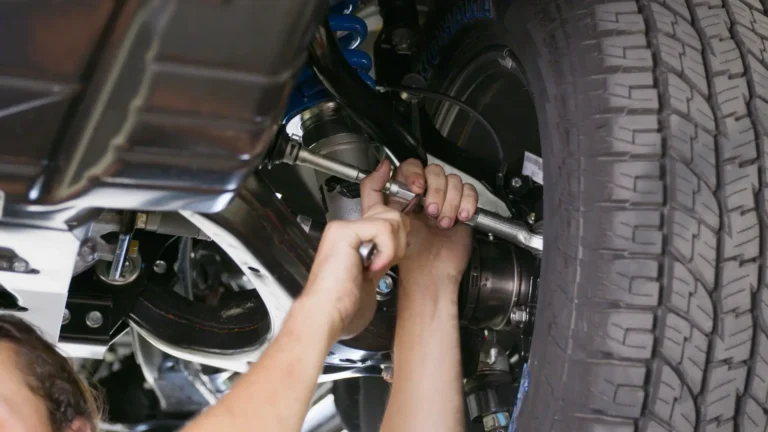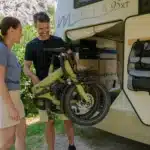
In this second instalment of our beginner’s guide to eBikes series, we take a look at what you should consider when buying an eBike.
eBikes are ridiculously popular these days, and for good reason. They offer a perfect balance between exercise and convenience, giving you that extra boost when you’re out exploring or just taking it easy. But aside from the usual things to think about when buying an eBike, for those of us travelling in an RV, there are a few special considerations to keep in mind. You need an eBike that’s practical, easy to store, and suited to your adventurous lifestyle. Here’s everything you should think about (in no particular order) before taking the plunge into buying an eBike.
#1. The weight of your eBike
Nobody wants to be struggling with a heavy bike when loading and unloading from an RV. The weight of an eBike can vary, especially with the addition of the battery and motor. If you’re on the move a lot, you’ll appreciate a lightweight model that you can manage without too much effort.
Aluminium or carbon frames are ideal for keeping the weight down while still being strong and durable. As a rule of thumb, try to stay within the 15-20 kg range, but don’t forget that lighter bikes may come with compromises in terms of battery life or sturdiness. When buying an eBike, it’s important to find the right balance between weight, features and quality for your travel needs.

#2. Tyre type and sizes
Now, let’s talk tyres. What kind of terrain do you plan on riding? The type of tyre can make all the difference when it comes to comfort and performance.
- Fat tyres: These are wide, knobby tyres designed for handling rougher terrain, like sandy beaches, gravel tracks, and even snow. They provide extra grip and stability, which can come in handy if your adventures take you off the beaten path. The downside? They’re heavier and can add some extra bulk.
- Regular tyres: If you’re sticking to paved roads or smoother trails, regular tyres will do the job. They’re lighter, provide a smooth ride on even surfaces, and are generally easier to transport and store. However, if you buy an eBike with regular tyres, you might struggle a bit if you venture into bumpier, off-road areas.
- Tyre sizes: Most eBikes come with wheels ranging from 20 inches for compact models up to 26-28 inches for more traditional setups. Smaller tyres make the bike more portable, which is a bonus for RVers, but they can feel a bit twitchy on rough ground. Larger tyres offer a smoother ride but can add to the overall bulk of the bike.

#3. Pedal assist vs throttle – How much power do you want?
In Australia, eBikes typically come with two main options for how the motor helps you ride: pedal assist (also called Pedelec) and throttle.
- Pedal assist: This is the most common type you’ll find when buying an eBike. In this mode, the motor kicks in when you start pedalling. It gives you a boost based on how hard you’re pushing the pedals, making uphill climbs or long rides less of a workout. You can usually also adjust how must assistance the bike provides. This is ideal for those who want to keep pedalling but need a little help.
- Throttle: With a throttle, you can kick back and let the motor do all the work without pedalling at all. It’s a fun option for short commutes or if you’re cruising around the caravan park. Although throttle eBikes and eScooters sometimes get a bad rep, they are ideal for people who don’t have the same fitness and mobility as they used to, allowing them to enjoy bike riding for longer and without the physical strain that comes with a lower-powered bike. When buying a throttle eBike, keep in mind that there are some rules surrounding its usage, which we talked about in our previous article, Beginner’s guide to eBikes.

#4. Cargo and load capacity: Will you be carrying anything extra?
When buying your eBike, consider whether you’ll need to carry any extra cargo. Some eBikes come with built-in racks or the option to add them, making it easy to transport gear, groceries, or even the dog! This is especially handy if you’re using the eBike for running errands at your campsite or exploring local markets.
Although eTrikes nearly always have a cargo basket on the back, regular two-wheel eBikes don’t necessarily have the space. As a result, cargo-carrying capacity varies from bike to bike. So, if you’re planning to load up with extra weight, make sure it can accommodate not just racks/baskets, but can handle the weight with a sturdier frame and higher load limits. If you have a lot to carry, some eBikes are even designed with dedicated cargo storage solutions, like large front or rear baskets.

#5. Battery life and charging options
Battery life is a crucial consideration when buying an eBike, especially if you plan to use it for longer trips. The range of eBike batteries can vary significantly, so choose one that suits your travel style. If you’re going to be mostly riding short distances between campsites or around town, a lower-capacity battery might be fine. But if you’re planning longer adventures, opt for a higher-capacity battery that can keep you going without constantly needing to recharge.
Since RVers sometimes camp off-grid, check whether the eBike’s battery can be charged via your RV’s solar setup or a portable power station. Removable batteries are a big plus, as they can be charged inside your RV while the bike stays outside.

#6. Transporting and storing your eBikes
Space in your RV is like gold. This is where foldable eBikes come into play. These bikes can usually be packed down small enough to tuck away neatly in your RV’s storage or at least in the cabin area of your motorhome/caravan.
If you’re looking at buying a folding eBike, look for one that folds easily without a bunch of fiddly parts that take forever to assemble. Some foldable models even come with a handy storage bag, making them easier to pack and protect during your travels. Always double-check the folded dimensions to ensure it’ll fit where you plan to store it in your rig.
You don’t necessarily have to go for a folding eBike, though, as some RVs allow for you to mount an external bike rack on the rear or the hitch of your vehicle. It’s important to note that it’s not as simple as bolting them on and hoping for the best as it’s not a one-size-fits-all approach. Adding anything of weight to your RV requires both structural and safety considerations. Read some common mistakes in our 5 things to consider when fitting caravan bike racks articles.


#7. Consider your eBikes versatility: What will you be using it for?
Are you going to be cruising around caravan parks, hitting scenic trails, or a mix of both? Your intended use will determine the type of eBike you should get.
- City riding: If you’re mainly sticking to roads and paths, a compact folding eBike with thinner tyres will do the job just fine.
- Trail riding: For those planning to take their eBike off-road, fat tyres and more durable frames will provide the extra grip and shock absorption you need.
- Mixed-use: If you’re a bit of both, consider a hybrid eBike that can handle a variety of terrains. These bikes offer a balance between comfort and capability, making them ideal for RVers who want versatility.
#8. Warranty and repairs
Last but not least, consider how difficult it will be to repair under warranty or undertake any repairs. Are parts readily available? Is it a well-known brand with a good reputation? How long a warranty does the manufacturer offer?
In a nutshell, it all boils down to this
Buying the right eBike for you, whether you’ll be taking it RVing or not, boils down to a few key factors: how portable and light it is, what terrain you’ll be riding, and what kind of features you need. Whether you’re after a foldable bike to save space, fat tyres for off-road adventures, or the convenience of a throttle, there’s an eBike out there to suit your lifestyle. Just make sure it fits your needs, and you’ll be cruising in no time.
Happy riding and safe travels!
Read next:












